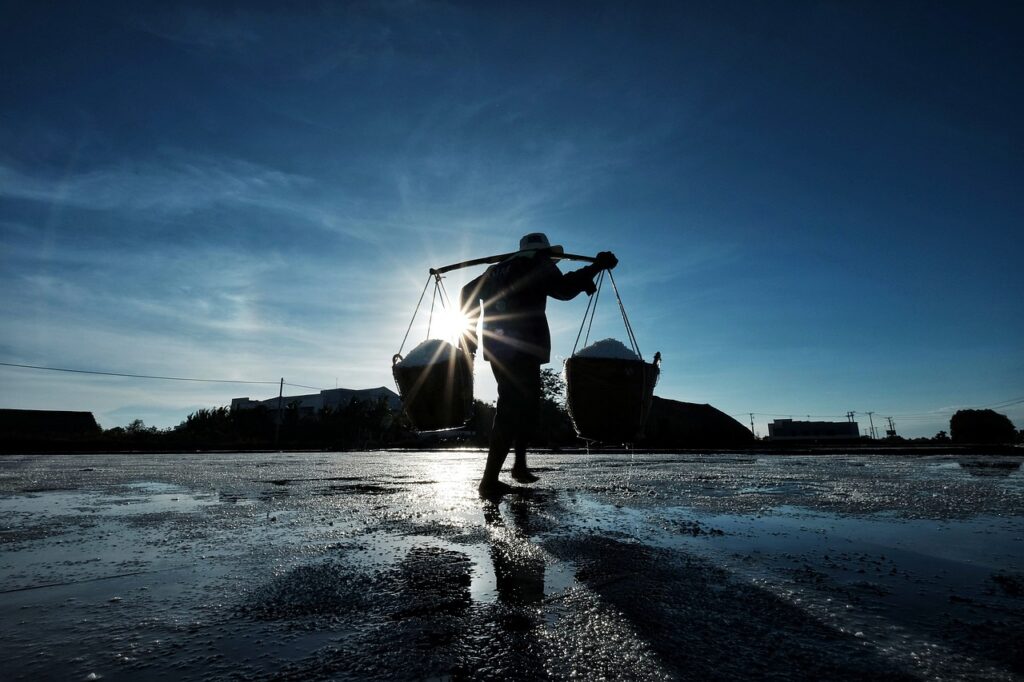
Modern slavery, as defined for the purpose of the global estimates, is comprised of two principal components – forced labour and forced marriage. Both refer to situations of exploitation that a person cannot refuse or cannot leave because of threats, violence, deception, abuse of power or other forms of coercion.
The scourge of modern slavery has by no means been relegated to history. The 2021 Global Estimates indicate that 49.6 million people are in modern slavery on any given day, either forced to work against their will or in a marriage that they were forced into. Forced labour accounts for 27.6 million of those in modern slavery and forced marriage for 22 million.
Forced labour, as set out in the ILO Forced Labour Convention, 1930 (No.29), refers to “all work or service which is exacted from any person under the menace of any penalty and for which the said person has not offered himself voluntarily.”
There are 27.6 million people in situations of forced labour on any given day. This absolute number translates to 3.5 people in forced labour for every thousand people in the world. Women and girls make up 11.8 million of the total in forced labour. More than 3.3 million of all those in forced labour are children.
Forced labour has grown in recent years. A simple comparison with the 2016 global estimates indicates an increase of 2.7 million in the number people in forced labour between 2016 and 2021, which translates to a rise in the prevalence of forced labour from 3.4 to 3.5 per thousand people in the world. The increase in the number of people in forced labour was driven entirely by forced labour in the private economy, both in forced commercial sexual exploitation and in forced labour in other sectors.
The initial months of the COVID-19 pandemic were accompanied by widespread reports of forced labour linked to the crisis. Disruptions to income because of the pandemic led to greater indebtedness among workers and with it reports of a rise in debt bondage among some workers lacking access to formal credit channels. The crisis also resulted in a deterioration of working conditions for many workers, in some cases leading to forced labour. Yet little is known about how forced labour risks have evolved since the initial months of the crisis, as strict economy-wide workplace shutdowns were phased out in most countries and the world economy began its fragile recovery. There are many reasons for concern in this regard. The World Bank indicates that extreme poverty – one important metric of forced labour risk – remains far higher than the pre-pandemic trajectory and the ILO reports that the jobs recovery has stalled in much of the world.
No region of the world is spared from forced labour. Asia and the Pacific is host to more than half of the global total (15.1 million), followed by Europe and Central Asia (4.1 million), Africa (3.8 million), the Americas (3.6 million), and the Arab States (0.9 million). But this regional ranking changes considerably when forced labour is expressed as a proportion of the population. By this measure,
forced labour is highest in the Arab States (5.3 per thousand people), followed by Europe and Central Asia (4.4 per thousand), the Americas and Asia and the Pacific (both at 3.5 per thousand), and Africa (2.9 per thousand).
Forced labour is a concern regardless of a country’s wealth. More than half of all forced labour occurs in either upper-middle income or high-income countries. When population is taken into account, forced labour is highest in low income countries (6.3 per thousand people) followed by high income countries
(4.4 per thousand).
Most forced labour occurs in the private economy. Eighty-six per cent of forced labour cases are imposed by private actors – 63 per cent in the private economy in sectors other than commercial sexual exploitation and 23 per cent in forced commercial sexual exploitation. State-imposed forced labour accounts for the remaining 14 per cent of people in forced labour. Forced labour touches virtually all parts of the private economy. The five sectors accounting for the majority of total adult forced labour (87 per cent) are services (excluding domestic work), manufacturing, construction, agriculture
(excluding fishing), and domestic work. Other sectors form smaller shares but nonetheless still account for hundreds of thousands of people. These include adult workers who are forced to dig for minerals or perform other mining and quarrying work, fishers who are trapped in forced labour aboard fishing vessels, people forced to beg on the street, and people forced into illicit activities.
The composition of forced labour differs from that of the broader labour force in a number of ways. The share of migrants in the group of people in forced labour is much higher than the share of migrants in the overall labour force. There are also relatively more men among workers in forced labour compared to the labour force generally. People in forced labour are more likely to be in manufacturing, and much more likely to be in construction, than workers in the overall labour force. They are less likely to be in the services and agriculture sectors than workers in the overall labour force.
People in forced labour exploitation are subjected to multiple forms of coercion to compel them to work against their will. The systematic and deliberate withholding of wages, used by abusive employers to compel workers to stay in a job out of fear of losing accrued earnings, is the most common form of coercion, experienced by 36 per cent of those in forced labour. This is followed
by abuse of vulnerability through threat of dismissal, which was experienced by one in five of those in forced labour. More severe forms of coercion, including forced confinement, physical and sexual violence, and the deprivation of basic needs, are less common but by no means negligible.
Forced labour in the private economy has an important gender dimension. Women in forced labour are much more likely than their male counterparts to be in domestic work, while men in forced labour are much more likely to be in the construction sector. Women are more likely to be coerced through wage
non-payment and abuse of vulnerability, and men through threats of violence and financial penalties. Women are also more likely than men to be subjected to physical and sexual violence and threats against family members.
Migrant workers face a higher risk of forced labour than other workers.
The forced labour prevalence of adult migrant workers is more than three times higher than that of adult non-migrant workers. This figure makes clear that when migrant workers are not protected by law or are unable to exercise their rights, migration is irregular or poorly governed, or where recruitment practices are unfair or unethical, migration can lead to situations of vulnerability to forced
labour.
An estimated 6.3 million people are in situations of forced commercial sexual exploitation at any point in time. Gender is a key determining factor: nearly four out of every five people trapped in these situations are girls or women.
The tragedy of children subjected to forced labour demands special urgency. A total of 3.3 million children are in situations of forced labour, accounting for about 12 per cent of all those in forced labour. And because of data constraints, these numbers, already alarming, may well be just the tip of the iceberg. The forced labour of children constitutes one component of child labour,4 which the international community – through Target 8.7 of the Sustainable Development Goals – has committed to ending by 2025.
The forced labour of children occurs across wide array of economic sectors and industries. Over half of all children in forced labour are in commercial sexual exploitation.
Domestic work, agriculture, and manufacturing are among the many other sectors where children in forced labour are found. Qualitative reports indicate that children can be subjected to severe forms of coercion and abuse, including abduction, drugging, being held in captivity, deception, and manipulation of debt. Some of the worst abuses occur in situations of armed conflict.
The 2021 Global Estimates indicate that 3.9 million people are in state-imposed forced labour at any point in time. Males make up more than three of every four of those in forced labour imposed by state authorities, while 8 percent of those in state-imposed forced labour are children. Over half (55 per cent) of all cases involve some form of abuse of compulsory prison labour, 27 per cent involve the abuse of conscription and 17 per cent involve forced labour for economic development or for work beyond normal civic obligations.
from “Global Estimates of Modern Slavery
Forced Labour and Forced Marriage”
© International Labour Organization (ILO), Walk Free, and International
Organization for Migration (IOM) 2022

